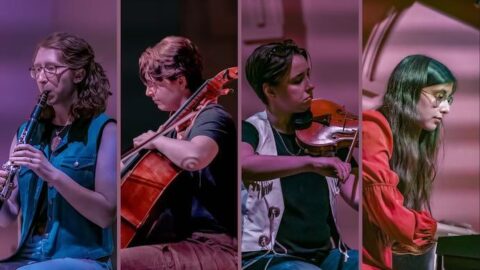I missed the “Yeehaw Agenda” era that dominated the socials a few years ago, so when the OLEA chamber ensemble encouraged audiences to wear their yeehaw gear to their June 8 concert, the only thing I had on hand were some denim shorts. The audience at The Southgate House Revival in Newport, Kentucky was modest but robust; a series of small tables with four chairs apiece were set up in the center of the sanctuary, a church converted into a bar/event space. A significant slice of empty floor separated the audience from the stage, where the musicians were illuminated with shades of magenta and violet. The intro music pumped through the speakers: selections from Beyoncé’s Cowboy Carter, a sign that this celebration of western/country/American folk culture was going to be anything but standard.
OLEA splits their time between Chicago and Cincinnati; the latter, due to its size, also includes Northern Kentucky. As stated on their website, OLEA aims for their concerts to be engaging and interactive. For their “YEEHAW: American Folk Traditions” program, each piece was introduced by one of the ensemble members, and laminated cards with QR codes took audiences to a visually engaging map that showed the composer’s location or the location that inspired the work. Of the seven pieces featured, only two were arrangements; the rest were either written for duo, trio, or OLEA’s uncommon and underappreciated instrumentation of violin, clarinet, cello, and piano.
Inspired by the Colorado River, Mason Bates’ Red River featured the full ensemble with electronics. It was the perfect opener: evocative of water and immersion through the consonant tonality, luscious melodic and motivic lines, and blend of different instruments, particularly in the unified moments between clarinetist Kate Kilgus and violinist Alayne Wegner with cellist J Holzen’s magnificently rich tone.

Next was an arrangement of Florence Price’s Adoration for clarinet and piano. Originally written for organ, it is one of Price’s most popular instrumental works, recovered in 2009. Kilgus and pianist Marissa Kerbel expertly phrased their setting of this piece, magnifying the beauty in the spareness of texture and melody. Though not based on a folk song, the different arrangements of Adoration that have appeared over the years serve as a reminder that classical works have morphed into new and reimagined settings for centuries, akin to the multiple, idiosyncratic versions of folk material that we’re used to hearing and performing.
This theme flowed into the next work; in Silver Dagger, Stacy Garrop drew upon three different versions of the popular folk song. Scored for violin, cello, and piano, the work opens with a hushed, tentative quality. It grows in dissonance and activity with sequential, contrapuntal exchanges between the trio, shifting to moments of melodic alignment between violin and cello before fragmenting and moving to harmonics that fade away.
Libby Larsen’s Rodeo Queen of Heaven – inspired by Arthur Lopez’s Madonna and Child in rodeo garb – featured moments of gorgeous ensemble blend on stinging, skewed chords that they let ring beautifully. Kerbel provided a fierce foundation in the sections where jazz rhythms emerged, toeing the line between New Orleans and experimental tonalities.
While impressive in Larsen’s work, rhythmic integrity in two of the selections occasionally faltered. Scott Joplin’s Ragtime Dance, arranged by Roe Goodman for clarinet, cello, and violin, was charming and light, but it seemed to take a moment for the players to truly lock into the rooted, laid-back syncopation. Foot stomping in the middle section was a great audience participatory moment, though, one of several that evening. Similarly, there was initially a lack of dedication to the rhythmic character in the first movement of Jessie Montgomery’s Duo for violin and cello; but once Wegner and Holzer settled into the fluid string crossings and pizzicato, the movement’s irreverence began to glimmer, and could have been even more exaggerated.

Bootleg Hoedown by Brain Raphael Nabors closed the program, a strategic choice since he is a doctoral graduate of the University of Cincinnati’s College Conservatory of Music (CCM) (three of OLEA’s members are also CCM alum or current students). The work was exuberant, with fiddle ostinatos, stomping, glissandi, and knocking, and a jazz rhythm that under Kerbel’s fingers turned deliciously sinister.
Though only three years old, OLEA is an ensemble that plays together. This might seem redundant, but you’d be surprised how many quartets play together without playing together. OLEA’s sense of timing, phrasing, blending, and emerging from the texture was not only inspiring, but refreshing. It was particularly moving considering Kerbel was playing on a keyboard rather than a piano; her phrasing, articulation, and use of color always supported or enhanced the group.
There is no “new/experimental” music venue in the Greater Cincinnati region a la NYC’s Roulette or Chicago’s Constellation. Instead there are bars, bookstores, radical art galleries, and museums that provide opportunities to hear music that is unfamiliar. Through their artistry, OLEA proved to its audience that these works are substantive, challenging, and perhaps most importantly, enjoyable. Why wouldn’t we choose to hear them again?
I CARE IF YOU LISTEN is an editorially-independent program of the American Composers Forum, and is made possible thanks to generous donor and institutional support. Opinions expressed are solely those of the author and may not represent the views of ICIYL or ACF.
You can support the work of ICIYL with a tax-deductible gift to ACF. For more on ACF, visit the “At ACF” section or composersforum.org.
























